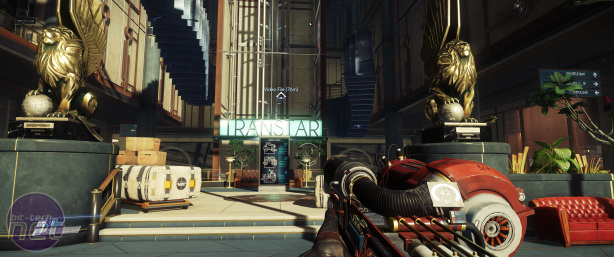
AMD Radeon RX 580 CrossFire in Prey at 3,440 x 1,440
Editor's note: This piece was commissioned by AMD. We were asked to look into RX 580 performance in Prey at an ultra-wide resolution. Users can read more about the AMD Radeon RX 580 by following this link. AMD supplied the CPU used for test system here - it's our original review sample - but all other hardware was sourced elsewhere. The benchmark is one of our own creation. AMD had no say in the results or presentation that follows hereafter.There is often debate as to which resolution is best to game at. At the lower end of the budget, monitors with a 1080p (1,920 x 1,080) resolution rule supreme. Also known as FHD, this setting is a good starting point for your gaming adventures, as the vast majority of TVs still use it. What's more, with the Sony PlayStation 4 and Xbox One still working best when outputting to FHD, it should be the minimum standard for gaming.
Over the past few years, a QHD resolution touting 2,560 x 1,440 pixels has become popular, and it certainly won't have escaped your attention that UHD, or 4K (3,840 x 2,160), has been the buzzword in the previous 24 months. Games look better as you raise the resolution, though the benefits of 4K are not that readily perceivable if the game's engine isn't cutting edge.
Yet there is a resolution that isn't talked about much from a gaming point of view and is therefore, in our opinion, overlooked unnecessarily. It happens to be an ultra-wide setting that takes in a 3,440 x 1,440 resolution commonly found on 34in monitors. Not only is it a boon for productivity, ostensibly through lots more lateral real estate, but you literally see more when gaming.
The near-5MP load means that premium graphics cards are needed for super-smooth gameplay, because there are more pixels to render than with regular QHD. Two approaches can be adopted for this: go for a single, expensive GPU or, if budgets are tighter, purchase a cheaper card and then add a second, in multi-GPU form, at a later date.
We mention all this because gaming at 3,440 x 1,440, particularly with adaptive refresh rate technology such as FreeSync, is immersive. The next question is what kind of system would one need to drive a pleasurable gaming experience with this kind of gaming monitor? AMD reckons that its Radeon RX 580 is a good fit in the premium mainstream space, because it offers solid performance with one card run at 3,440 x 1,440 but, through internal CrossFire to enable two cards to work together, excellent gaming when two cards are hooked up - something which the rival GeForce GTX 1060 cannot do; the GTX 1070 is the lowest card in Nvidia's current stack with multi-GPU (SLI) support.
You may have heard that Prey was released on multiple gaming platforms recently. Arriving to critical acclaim, AMD reckons it's a title that scales well with the latest Radeon GPUs, so much so that it invited us to benchmark the Radeon RX 580 on an ultra-wide monitor outfitted with the 3,440 x 1,440 resolution we like to game upon.
Putting the building blocks together, we used an AMD Ryzen 5 1600 CPU, Gigabyte B350 motherboard, 8GB of DDR4-2666 memory, and a 256GB SSD and paired them with a Sapphire Radeon RX 580 Nitro+ Limited Edition to see how well one or two cards performed at the ultra-wide resolution. Image quality settings were set to 'Very High', the highest available.
What this graph shows is that Prey is a well-optimised game that runs well at this resolution allied to best-in-class image quality settings. However, when the action becomes frenetic and those pesky enemies are all over you, one can feel the less-than-perfect rendering.
Enter a second card, which in CrossFire mode improves the frame rate markedly. We see a 75 percent increase in performance, but more importantly, the minimum frame rate, which is the true arbiter of how smooth a game feels, doesn't drop below 60fps. One can game with V-Sync turned on 60Hz, though the best gaming experience is availed through a gaming-specific ultra-wide monitor such as the Philips Brilliance 349X7FJEW which offers FreeSync technology at up to 100Hz.
What this means in practice is that when the Ryzen system is equipped with two Radeon RX 580 GPUs, the game is lusher, tear-free, and enjoyable, especially if paired with a FreeSync-compatible ultra-wide screen.
You don't need to spend a whole heap of cash on a base unit to avail yourself of a great gaming experience on an ultra-wide screen. Equipping our Ryzen 5 1600-based system with a couple of RX 580s and the usual accoutrements brings the budget in at around £1,000.
Our look at a particular gaming title, Prey, and the latest mainstream AMD hardware shows that a solid gaming experience at our favourite resolution of 3,440x1,440 can be had for less than the price of a single high-end processor from the competition. Food for thought, huh?
Editor's note: This piece was commissioned by AMD. We were asked to look into RX 580 performance in Prey at an ultrawide resolution. Users can read more about the AMD Radeon RX 580 by following this link. AMD supplied the CPU used for test system here - it's our original review sample - but all other hardware was sourced elsewhere. The benchmark is one of our own creation. AMD had no say in the results or presentation above.

MSI MPG Velox 100R Chassis Review
October 14 2021 | 15:04









Want to comment? Please log in.